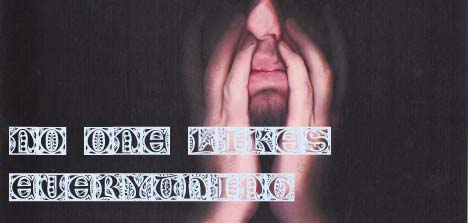From the MeFi thread. Someone asked for brief descriptions about each of these "influential" albums.
Suicide— s/t
This, along with the Silver Apples, was one of the first "synthesizer" albums, and definitely the first "New York" synthesizer albums. Urban, dark, decadent and, well, dancy. Without this, no Joy Division.
Lou Reed— Metal Machine Music
Noise kills record contracts dead. The first noise album on a major label, and a huge influence for people constructing cacophonics. Without this, no Einsturzende Neubauten.
Christian Marclay— Record Without Grooves
Vinyl played wrong. Without this, many people wouldn't see the turntable as an instrument all unto itself.
Miles Davis— Bitches Brew
People like to talk about the studio as instrument and laud The Beatles and Beach Boys. This is where you could take it if you weren't trying to accomodate a bunch of music hall bullshit.
John Coltrane— A Love Supreme
Coltrane's influence in saxophone players is a hard thing to quantify, in that a lot of people would love to play like him but can't (me, especially). This album is both accessible and mindblowing, and solidified a lot of the ideas of modern/free jazz while not being Om (which is great, but is not for passive listening).
La Monte Young— Well Tuned Piano
Young's drone work was an important influence on Krautrock and all minimal avant garde, including Phillip Glass.
John Cage— 4'33"
Karlheinz Stockhausen— Kontakt
One of the first compositions to combine live performers with electronics and tape loops, Stockhausen laid some of the foundation for things like DAT triggering. It's also good to listen to.
Edgard Varese— Poem Electronique
More avant electronics. Le Corbusier commissioned this tape piece from Varese as part of an architectural multimedia installation, and it pushed the conceptual boundaries of electronic composition. Varese was aided by Le Corbusier's assistant Iannis Xenakis, who became one of the most famous of the electro-minimal composers.
Raymond Scott— Powerstation
Raymond Scott's Looney Tunes work permeated the dreams of a generation. Maybe not as influential in terms of, well, being an album, but his use of odd instrumentation and experimental effects can be traced down to bands as diverse as the Mothers of Invention to Lighting Bolt.
Charles Mingus— New Tijuana Moods
The American middle ground between Modern jazz and Latin jazz.
Thelonius Monk— Brilliant Corners
I said s/t when I was running through things from the top of my head, but I should have said this one. Syncopated, abrupt, jarring, nimble, quick. Art Blakey's the sax and this 1956 disc is another that changed how composition was considered.
The Raspberries— Fresh
Power pop started around here somewhere, and the 1972 Rasberries wanted to be the 1969 Nazz (or maybe Badfinger). Either way, they got close enough.
Big Star— #1 Record
This album is probably the biggest omission. Without it, no REM, no Cheap Trick, no power pop as we know it.
Minor Threat— Minor Threat
xxstraightedgexx! Hardcore punk's best and most influential album.
Rites of Spring— End on End
I don't really like emo, but this is where it comes from.
Fugazi— Repeater
Once upon a time, emo was really more "post-hardcore." This is post-hardcore at its finest. Another one of those "without them, no Lightning Bolt" sort of bands.
Husker Du— Zen Arcade
More post-hardcore. But seriously, without them, no My Chemical Romance or any of the other soft post-emo bands. (Don't let that count against Husker Du...)
Wire— Pink Flag
Post-punk at its tightest. These guys were huge influences on REM and most of indie rock.
Wire— Chairs Missing
And they kept changing. The indie-meets-electronic stuff they're doing here (which had been preceded by Suicide above) is just now starting to crest. No Franz Ferdinand, no Futureheards, no Bloc Party without this album.
Gang of Four— Entertainment
The funky side of post-punk. No TV on the Radio, no Franz Ferdinand, no Bloc Party.
I'll get to the rest of them later...

No comments:
Post a Comment